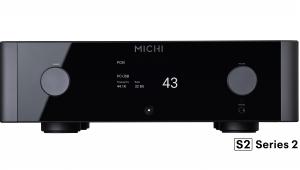Audiolab 6000A Amplifier/DAC

 This latest variation on Audiolab's integrated amplifier theme lacks the sheer grunt of its 8300 big brother but seems none the worse for it, and looks better value too
This latest variation on Audiolab's integrated amplifier theme lacks the sheer grunt of its 8300 big brother but seems none the worse for it, and looks better value too
Audiolab's 8000A first appeared on dealers' shelves in October 1983, and was arguably the least fashionable new integrated amplifier for a long time. It was everything that the cool audiophile cognoscenti of the time didn't like. How could anyone possibly produce a supposedly modern product fitted with tone controls, a headphone socket, independent source and tape switching and – perish the thought – a balance control? It was the very antithesis of what the sparse, minimalist, less-is-more 1980s was about. Despite this however, it sold like hot cakes at Christmas…
Amazingly, it turned out that hi-fi buyers did actually crave its plentiful facilities and 50W per channel rated power output. Better still, it proved highly reliable in an age where this could not always be taken for granted. The 8000A continued to improve for the next fifteen years or so, given a subtle colour change from gunmetal grey to black, plus a 'CD' input, more power and better sound.
A Racing Certainty
Warp forward a further two decades to 2015, during which time Audiolab had become TAG McLaren Audio and then back to Audiolab again, and the 8300 successor was launched for the princely sum of £899 [HFN Mar '16]. Boasting better ergonomics with a new digital display and a further power increase, it has gone from strength to strength. And now the new £599 6000A is here, which is essentially a lower-powered version of the 8300 minus its balanced inputs. With the same claimed 50W power output as the original 8000A, think of it as the true spiritual successor to Audiolab's classic integrated.
As well as three analogue line inputs, the 6000A offers DAC functionality and aptX Bluetooth connectivity, plus a FET-based MM phono stage to keep the vinylistas happy. The company stresses that these aren't mere 'tick box' features, designed to fill space in a brochure specs list. Bold claims are made for the digital stage in particular – it sports an ESS Sabre ES9018 converter chip, as seen on the M-DAC [HFN Sep '12], and the digital filter has three user-selectable settings: Fast Roll-Off, Slow Roll-Off and Minimum Phase.

The four S/PDIF digital inputs – two coaxial and two optical – run at up to 192kHz/24-bit PCM, but there's no support for DSD. In truth, few Audiolab buyers will really miss this, and what's more important is the decently spec'd Class AB power amp rated at 50W/8ohm and 75W/4ohm.
Audiolab says its output stage uses a complementary feedback topology, claimed to give better linearity and thermal stability, its performance remaining independent of heatsink temperature. The PSU features a 200VA toroidal transformer and 4x15,000μF of reservoir caps while the preamp section offers volume adjustment over a –80dB to +8dB span in 2dB, and then, finally, 1dB steps.
In practice the 6000A is a delight to use. The company has abandoned its gaudy brushed aluminium fascias of a few years ago for a simpler painted finish that looks subtle and tasteful. Ergonomically it's intuitive enough, its Mode selector and small display used in conjunction to vary the balance, digital filter type and standby time.
The amp has three main modes – integrated amplifier, split pre/power and preamplifier, so there's plenty of flexibility for people slowly ascending the upgrade ladder, and perfect for an affordable product such as this. Overall, the general look and feel of the 6000A totally belies its price as it looks, behaves and sounds like a far pricier product.
![]() House Music
House Music
To any owner of the original 8000A, the character of this new integrated will be reassuringly familiar. Indeed, it's almost uncanny that the classic amp's basic way of going about making music is still here, after all those years. There are some subtle differences of course, but the Audiolab 'house sound' has largely been retained.
All this suggests a spry and crisp way of making music, and the diametric opposite of the 'rich and rose-tinted' school of design. Everything is taut, tight, orderly and measured, so the music comes at you in a positive, engaging way but there's no great romance either to the tone or emotional aspect of its delivery.
Cue up Change's 'A Lover's Holiday' [from The Glow Of Love; Warner Bros. Records 3438-2], and you're instantly taken aback by the precision of the sound. This is a beautifully recorded analogue disco/funk track from 1980, and its innate warmth gives the 6000A a chance to shine via its (analogue) line inputs.
























































